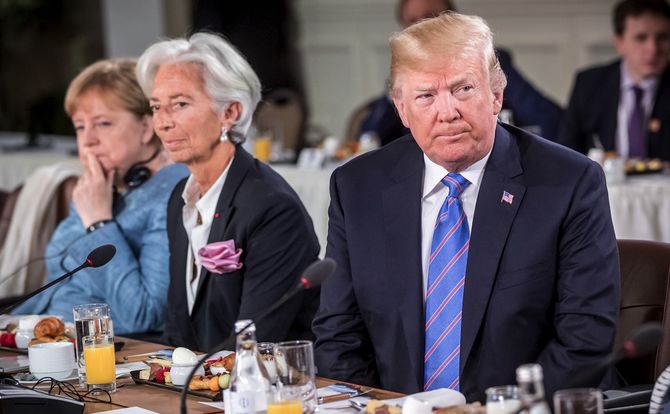U.S. security policy toward Europe: The next phase
One of the most frequently asked questions about President Donald Trump’s foreign policy is what it plans to do about Europe. The answer to that is now clearer, though not necessarily the disaster for transatlantic relations that the G7 summit in Quebec appeared to be.

In a nutshell
- Transatlantic frictions were on display at the G7 summit, but appearances can deceive
- The Trump administration’s underlying security commitment to Europe remains strong
- Yet disagreements on missile defense, Iran, tariffs and EU politics won’t be easily resolved
One of the most frequently asked questions about American foreign policy following the election of President Donald J. Trump was what it planned to do about Europe. On the campaign trail, the candidate’s remarks were jarring, confusing and contradictory. His first year in office provided a sharp contrast, as representatives of the new administration did much to reassure Europe of the United States’ commitment to NATO and transatlantic security. But that did little to clarify where Washington planned to take the relationship in the future.
The answer to that question is now much clearer. While the G7 summit in Quebec was by any measure a disaster, its impact on transatlantic relations will likely be ephemeral and offers little insight into U.S. policies. What Washington really has in mind is still unsettling, however. It remains committed to advancing regional security, but with greater stress on bilateral ties, and using much more combative economic policies.
Even so, some concerns about a sharp break from traditional American policies toward Europe can now be dismissed out of hand. This administration is clearly not isolationist. The U.S. remains deeply committed to NATO. It has reaffirmed support for Ukraine and Georgia. The White House clearly has not been soft on Vladimir Putin. And despite Mr. Trump’s support for Brexit, the administration is not out to deconstruct the European Union (EU).
Emerging strategy
That said, until recently it was far from clear what the U.S. intended to do for Europe besides reassuring its partners there that they would not be abandoned. While President Trump might be highly conventional in sustaining American commitment to the transatlantic relationship, it is also clear that his approach to foreign policy is unconventional.
Matters were further confused by the recent G7 summit, when the U.S. reversed course and rejected the final communique, prompting dire predictions about the state of European-American relations. The G7, however, has never been a forum for much more than photo ops and generic statements. The outcome of its latest meeting is strictly a one-off. Understanding long-term American policies toward Europe requires a deeper look.
Unclassified strategy documents cannot provide clarity on how proactive the U.S. intends to be.
Late last year, the White House published a new national strategy that singled out the transatlantic community as a cornerstone of American security. The U.S. clearly identified its view of the top security threats: Russia’s destabilizing actions and the potential for Middle Eastern troubles to spill over into Europe (Iran and terror groups such as Daesh and al-Qaeda were particular concerns). An unclassified strategy document, however, cannot provide much clarity on how proactive the U.S. intends to be to strengthen its position.
An interagency team was assigned to flesh out the details of that strategic direction. Key individuals involved included Dr. A. Wess Mitchell, an assistant secretary of state; Dr. Richard D. Hooker Jr. of the National Security Council; Robert Karem, the assistant secretary of defense for international security affairs; and Thomas W. Goffus, the deputy assistant secretary of defense for European and NATO policy. Release of the policy details was no doubt delayed by cabinet changes in the national security team, with Mike Pompeo taking over at the State Department and John Bolton at the National Security Council.
Soft underbelly
Recently, details of the new European security policy’s priorities have begun to emerge. Topping the list are plans to work with NATO allies on what are viewed as the weak points in the alliance’s perimeter – the Mediterranean and Southern Europe.
Two aspects of the Mediterranean plan deal with Turkey. While the prospect of warmer relations between Turkey, Europe and the U.S. looks bleak in the near term, the administration is not about to downgrade its association with Ankara. Washington plans to “stabilize our relationship with Turkey, and keep them on a westward path,” said one administration official. These intentions were confirmed by the recent meeting between Mr. Pompeo and Turkish Foreign Minister Mevlut Cavusoglu.

To stabilize relations, several contentious issues on military procurement and deployments will have to be defused. These include Ankara’s acquisition of the Russian S-400 air defense system, Turkish intervention in northern Syria against U.S.-backed Kurdish forces, and a growing protests against the sale of Lockheed Martin F-35 stealth fighters to Turkey.
The U.S. has already issued a flat-out warning that if the S-400 purchase proceeds, Turkey will not be allowed to buy F-35s. A senior U.S. official also declared Washington’s desire to “strengthen the Western presence in the eastern Mediterranean” and start “working a lot with Cyprus.” In addition to these diplomatic sticks, the U.S. is pushing hard to find common ground in Syria. That was reflected in a joint announcement of confidence-building measures between American and Turkish forces.
On NATO’s southern flank, the U.S. plans to increase its engagement in the Western Balkans and the Black Sea area. Of note is American support for the Three Seas Initiative, where cooperation on economic development could significantly strengthen American partners on the Baltic, in Central Europe and the Black Sea region. At the same time, American opposition is hardening to Nord Stream II (an expansion of the underwater pipeline transporting Russian natural gas to Europe via Germany), which Washington agrees will undermine efforts to strengthen energy security on NATO’s frontier.
Points of friction
More clues on U.S. security plans for Western Europe could be provided by the newest version of the Pentagon’s Ballistic Missile Defense Review, which is expected to be released in late June. The document has apparently been extensively revised to put more emphasis over the long term on developing capabilities to intercept Russian and Chinese ICBMs. This document, together with the review of arms treaties including the New START and INF instrument, could exacerbate disagreements within NATO over nuclear strategy.
These tensions would come on top of the friction generated by the Trump administration’s decisions to withdraw from the Iran nuclear deal (Joint Comprehensive Plan of Action, or JCPOA) and impose new tariffs on aluminum and steel imports.
Washington’s real aim is to use the tariffs as an instrument to exact more reciprocity in trade.
Europeans already seem to be at least tacitly accepting the American position on Iran, despite blustery EU rhetoric. Major European firms are already winding down their engagement to avoid running afoul of U.S. sanctions. Recently, for example, the French automaker PSA said it would pull out of Iran.
The imposition of aluminum and steel tariffs has the potential to cause serious rifts in the alliance, but whether that comes to pass remains to be seen – despite the heated rhetoric. Though the U.S. administration has declared the new tariffs are for “national security purposes,” that claim is untrue. Washington’s real aim is to use the tariffs as an instrument to exact more reciprocity in trade.
Here both sides have something to argue about. The overall average EU tariff is just above 5 percent, while the U.S. rate is about 3.5 percent. These figures do not necessarily reflect sectors on both sides where tariff rates are so high that very little trade occurs. The way to solve this problem is not for the government to impose new, burdensome import levies on American manufacturers. Instead, the U.S. and the EU should work together to lower existing tariff and nontariff barriers, allowing individuals to trade more freely. If both sides take that opportunity, the current trade dispute could subside quickly.
Internal politics
A last area of tension is the U.S.’s role in the EU’s ongoing disputes over efforts to further integration and combat the populist “revolt” that has swept through member states, most recently Italy.
Officially, the American position is not to interfere in the EU’s internal politics. Yet the Trump team has clearly shifted policies from the previous administration, which seemed increasingly to tilt toward the EU central authorities. Most noticeably, the U.S. stopped putting pressure on countries like Poland and Hungary for pursuing independent policies on sensitive matters such as immigration.
The U.S. will likely increase its commitment to forward defense in Europe, especially if its partners spend more.
Washington has also stopped funding groups that oppose conservative parties in Europe. The American ambassador to Germany, Richard Grenell, recently prompted a backlash of criticism for remarks that were interpreted as a U.S. effort to “empower” conservative voices in Europe. While the State Department quickly moved to clarify that this was not his intent, the flare-up highlighted the lingering suspicion and uncertainty about President Trump’s designs on the EU.
Finally, Europeans remain uncertain of future American commitments to enhance the region’s forward defense through a direct U.S. military presence. Tension has emerged between the National Security Council, which has pressed for augmented U.S. forces and bases in Central and Southern Europe, and the Defense Department, which is reluctant to take on new commitments without clear signals that the Pentagon will have increased funding over the long term. Europeans should probably not expect to receive clearer signals on this issue at the July NATO summit in Brussels.
Sunshine – with thunderstorms
The most likely near-term scenario is that the outlines of a deeper U.S. commitment to the security of Europe will appear – even as transatlantic relations stay mired in controversies over Iran and U.S. tariffs, the EU’s internal politics, and the growing resentment of President Trump in many quarters. For all the surface tension, none of that portends any serious weakening to the transatlantic community.
The U.S. will probably increase its direct commitment to European forward defense, particularly if its European partners raise their defense outlays and invest in infrastructure to improve inter-theater mobility and logistics, while enhancing energy security. We can also expect the U.S. to ramp up its bilateral engagement with the Nordic, Baltic, Central and Southern European nations along NATO’s “frontier,” including with countries now outside the alliance.
There is no question that some old concepts are dead – like the emphasis on NATO’s out-of-area capabilities. Washington’s myopic focus on counterterrorism is also waning fast. But that only leaves more room to deal with more urgent concerns about Russia, Iran and China as the U.S. revamps its security partnership with Europe.







